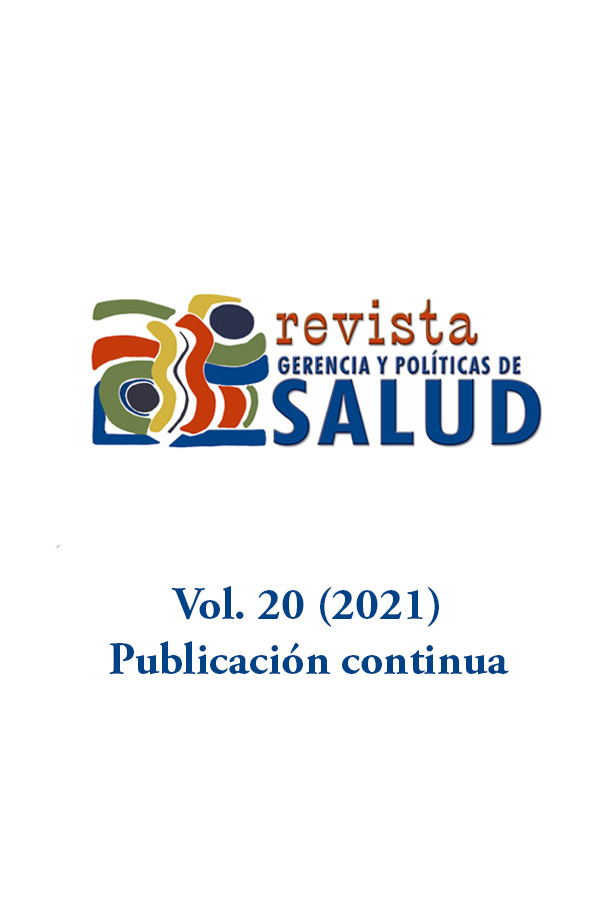Abstract
Introduction. Diseases like diabetes mellitus and high blood pressure are increasingly frequent worldwide, with significant associated social costs. Objective. To evaluate the prevalence of high blood pressure and diabetes in workers in the marketplace of a municipality in Antioquia, Colombia, and the associated risk factors. Methodology. An analytical cross-sectional observational study was conducted on a census of 194 workers, of which 152 had a medical-labor assessment and a survey of socio-demographic and labor data. A previous standardization of the evaluators was made with data quality control and univariate and bivariate data analysis, with IC 95%. Results. 57% were women, 73.4% earned less than the current legal monthly minimum wage; 65.8% worked between 9 and 12 hours, and 11.9% between 13 and 18 hours per day. 62.4% don’t engage in physical activity, and 67.0% prefer fried food. 20.9% had high blood pressure that was associated with marital status, age, seniority in the trade, systolic pressure at the time of evaluation, family history, and gender. 9.2% had diabetes mellitus, and this was associated with marital status, age, and systolic pressure at the time of evaluation. Conclusions. There is an informal working population with a high burden of disease and risk factors, which shows the need for public policies and programs specifically focused on their risk and lifestyles.
Jamison D, Etienne C. Prefacio. Las dimensiones económicas de las enfermedades no transmisibles en América Latina y el Caribe. Washington DC: OPS; 2017. p.V-VI. http://iris.paho.org/xmlui/bitstream/handle/123456789/33994/9789275319055-spa.pdf?sequence=1&isAllowed=y
Organización Mundial de la Salud (OMS). Informe sobre la situación mundial de las enfermedades no transmisibles. Ginebra; 2014. http://apps.who.int/iris/bitstream/handle/10665/149296/WHO_NMH_ NVI_15.1_spa.pdf;jsessionid=B2E3BF92C4778B75162AD8474655B658?sequence=1
World Health Organization (WHO). Causes of death 2008: Data sources and methods. Geneva; 2011. https://www.who.int/healthinfo/global_burden_disease/cod_2008_sources_methods.pdf
Lim SS, Vos T, Flaxman AD, Danaei G, Shibuya K, Adair-Rohani H, et al. A comparative risk assessment of burden of disease and injury attributable to 67 risk factors and risk factor clusters in 21 regions, 1990-2010: A systematic analysis for the Global Burden of Disease Study 2010. Lancet. 2012 Dec 15;380(9859):2224-2260. http://www.ncbi.nlm.nih.gov/pubmed/23245609
World Health Organization (WHO). Global status report on noncommunicable disease 2010. Geneva; 2011. http://www.who.int/about/licensing/copyright_form/en/index.html
World Health Organization (WHO). A Global Brief on Hypertension. Geneva; 2013. www.who.int/about/licensing/copyright_form/en/index.html
Farkouh ME, Rayfield EJ, Fuster V. Diabetes and cardiovascular disease. In: Fuster V, Harrington R, Narula J, Eapen Z (eds). Hurst’s The Heart, 14e. New York: McGraw-Hill Education; 2017. http://accessmedicine.mhmedical.com/content.aspx?aid=1154846897
Blanco A, Jacoby E, Monteiro M, Caixeta R, Smith B, Grajeda R, et al. Factores de riesgo en las Américas: orígenes de la carga. En: Las dimensiones económicas de las enfermedades no transmisibles en América Latina y el Caribe. Washington DC: OPS; 2017. p. 25-33. http://iris.paho.org/xmlui/bitstream/handle/123456789/33994/9789275319055-spa.pdf?sequence=1&isAllowed=y
Ministerio de Salud y Protección Social (MinSalud). Análisis de Situación de Salud Colombia. Bogotá; 2016. https://www.minsalud.gov.co/sites/rid/Lists/BibliotecaDigital/RIDE/VS/ED/PSP/asis-colombia-2016.pdf
World Health Organization (WHO). Global Health Observatory data repository. World Health Organization; 2018. http://apps.who.int/gho/data/node.home
Lund F. Social protection and the informal economy: Linkages and good practices for poverty reduction and empowerment. In: Promoting pro-poor growth: Social protection. Geneva: OECD; 2009. p.69-88. http://www.oecd.org/development/povertyreduction/43280700.pdf
Vélez C, Escobar M, Pico M. Determinantes sociales de la salud y el trabajo informal. Rev Costarr Salud Pública. 2013;22(2):156-162. https://www.researchgate.net/publication/263474018_Determinantes_sociales_de_la_salud_y_el_trabajo_informal
Gómez-Palencia IP, Castillo-Ávila IY, Banquez-Salas AP, Castro-Ortega AJ, Lara-Escarlate HR. Condiciones de trabajo y salud de vendedores informales estacionarios del mercado de Bazurto, en Cartagena. Rev Salud Pública. 2012;14:448-459. https://www.scielosp.org/article/rsap/2012.v14n3/448-459/
Briceño L, Pinzón AM. Trabajo infantil en una plaza de mercado de Bogotá, Colombia. Rev Salud Pública. 2005;7(1):26-38. http://www.scielo.org.co/pdf/rsap/v7n1/v7n1a3.pdf
Garzón-Duque MO, Cardona-Arango MD, Rodríguez-Ospina FL, Segura-Cardona AM. Informalidad y vulnerabilidad laboral: aplicación en vendedores con empleos de subsistencia. Rev Saude Publica. 2017;51:1-17. https://scielosp.org/pdf/rsp/2017.v51/89/es
International Labour Organization. Informal economy. 2018. http://www.ilo.org/ilostat-files/Documents/description_IFL_EN.pdf
Aschner P. Epidemiología de la diabetes en Colombia. Av en Diabetol. 2010;26(2):71-134. https://linkinghub.elsevier.com/retrieve/pii/S1134323010620054
American Diabetes Association. Obesity management for the treatment of type 2 diabetes. Diabetes Care. 2016;39(Suppl 1):S47-S51. http://www.ncbi.nlm.nih.gov/pubmed/26696681
American Diabetes Association. Lifestyle management: standards of medical care in diabetes. Diabetes Care. 2018 Jan;41(Suppl 1):S38-S50. http://www.ncbi.nlm.nih.gov/pubmed/29222375
Organización Panamericana de la Salud (OPS). Los impuestos a los refrescos y a las bebidas azucaradas como medida de salud pública. https://www.paho.org/mex/index.php?option=com_content&view=article&id=627:los-impuestos-refrescos-bebidas-azucaradas-medida-salud-publica&Itemid=499
Álvarez-Sánchez C, Contento I, Jiménez-Aguilar A, Koch P, Gray HL, Guerra LA, et al. Does the Mexican sugar-sweetened beverage tax have a signaling effect? ENSANUT 2016. PLoS One. 2018 Aug 22;13(8):e0199337. https://doi.org/10.1371/journal.pone.0199337
Colchero MA, Salgado JC, Unar-Munguía M, Molina M, Ng S, Rivera-Dommarco JA. Changes in prices after an excise tax to sweetened sugar beverages was implemented in Mexico: Evidence from urban Areas. Nugent RA. PLoS One. 2015 Dec 14;10(12):e0144408. https://dx.plos.org/10.1371/journal.pone.0144408
Organización Panamericana de la Salud (OPS). Estrategia para la prevención y el control de las enfermedades no transmisibles, 2012-2025. Washington DC; 2012. https://www.paho.org/hq/dmdocuments/2012/CSP28-9-s.pdf
Marmot MG. Status syndrome. JAMA. 2006;296(4):395-396. https://doi.org/10.1001/jama.296.4.395
International Labour Organization. Resolution concerning decent work and the informal economy; 2002. https://www.ilo.org/public/english/standards/relm/ilc/ilc90/pdf/pr-25res.pdf
Marmot M. Status syndrome: A challenge to medicine. JAMA. 2006;295(11):1304-1307. http://dx.doi.org/10.1001/jama.295.11.1304

This work is licensed under a Creative Commons Attribution 4.0 International License.
Copyright (c) 2021 Daniel Vasquez, María Osley Garzón-Duque, PhD



